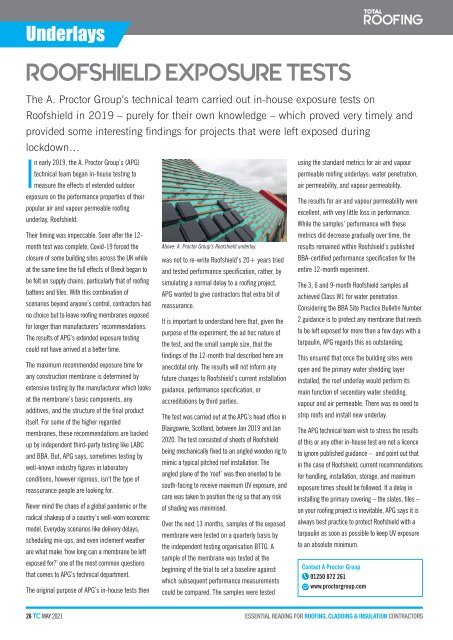May 2021
Create successful ePaper yourself
Turn your PDF publications into a flip-book with our unique Google optimized e-Paper software.
Underlays<br />
ROOFSHIELD EXPOSURE TESTS<br />
The A. Proctor Group’s technical team carried out in-house exposure tests on<br />
Roofshield in 2019 – purely for their own knowledge – which proved very timely and<br />
provided some interesting findings for projects that were left exposed during<br />
lockdown…<br />
In early 2019, the A. Proctor Group’s (APG)<br />
technical team began in-house testing to<br />
measure the effects of extended outdoor<br />
exposure on the performance properties of their<br />
popular air and vapour permeable roofing<br />
underlay, Roofshield.<br />
Their timing was impeccable. Soon after the 12-<br />
month test was complete, Covid-19 forced the<br />
closure of some building sites across the UK while<br />
at the same time the full effects of Brexit began to<br />
be felt on supply chains, particularly that of roofing<br />
battens and tiles. With this combination of<br />
scenarios beyond anyone’s control, contractors had<br />
no choice but to leave roofing membranes exposed<br />
for longer than manufacturers’ recommendations.<br />
The results of APG’s extended exposure testing<br />
could not have arrived at a better time.<br />
The maximum recommended exposure time for<br />
any construction membrane is determined by<br />
extensive testing by the manufacturer which looks<br />
at the membrane’s basic components, any<br />
additives, and the structure of the final product<br />
itself. For some of the higher regarded<br />
membranes, these recommendations are backed<br />
up by independent third-party testing like LABC<br />
and BBA. But, APG says, sometimes testing by<br />
well-known industry figures in laboratory<br />
conditions, however rigorous, isn’t the type of<br />
reassurance people are looking for.<br />
Never mind the chaos of a global pandemic or the<br />
radical shakeup of a country’s well-worn economic<br />
model. Everyday scenarios like delivery delays,<br />
scheduling mix-ups, and even inclement weather<br />
are what make ‘how long can a membrane be left<br />
exposed for?’ one of the most common questions<br />
that comes to APG’s technical department.<br />
The original purpose of APG’s in-house tests then<br />
Above: A. Proctor Group’s Roofshield underlay.<br />
was not to re-write Roofshield’s 20+ years tried<br />
and tested performance specification, rather, by<br />
simulating a normal delay to a roofing project,<br />
APG wanted to give contractors that extra bit of<br />
reassurance.<br />
It is important to understand here that, given the<br />
purpose of the experiment, the ad hoc nature of<br />
the test, and the small sample size, that the<br />
findings of the 12-month trial described here are<br />
anecdotal only. The results will not inform any<br />
future changes to Roofshield’s current installation<br />
guidance, performance specification, or<br />
accreditations by third parties.<br />
The test was carried out at the APG’s head office in<br />
Blairgowrie, Scotland, between Jan 2019 and Jan<br />
2020. The test consisted of sheets of Roofshield<br />
being mechanically fixed to an angled wooden rig to<br />
mimic a typical pitched roof installation. The<br />
angled plane of the ‘roof’ was then oriented to be<br />
south-facing to receive maximum UV exposure, and<br />
care was taken to position the rig so that any risk<br />
of shading was minimised.<br />
Over the next 13 months, samples of the exposed<br />
membrane were tested on a quarterly basis by<br />
the independent testing organisation BTTG. A<br />
sample of the membrane was tested at the<br />
beginning of the trial to set a baseline against<br />
which subsequent performance measurements<br />
could be compared. The samples were tested<br />
using the standard metrics for air and vapour<br />
permeable roofing underlays: water penetration,<br />
air permeability, and vapour permeability.<br />
The results for air and vapour permeability were<br />
excellent, with very little loss in performance.<br />
While the samples’ performance with these<br />
metrics did decrease gradually over time, the<br />
results remained within Roofshield’s published<br />
BBA-certified performance specification for the<br />
entire 12-month experiment.<br />
The 3, 6 and 9-month Roofshield samples all<br />
achieved Class W1 for water penetration.<br />
Considering the BBA Site Practice Bulletin Number<br />
2 guidance is to protect any membrane that needs<br />
to be left exposed for more than a few days with a<br />
tarpaulin, APG regards this as outstanding.<br />
This ensured that once the building sites were<br />
open and the primary water shedding layer<br />
installed, the roof underlay would perform its<br />
main function of secondary water shedding,<br />
vapour and air permeable. There was no need to<br />
strip roofs and install new underlay.<br />
The APG technical team wish to stress the results<br />
of this or any other in-house test are not a licence<br />
to ignore published guidance – and point out that<br />
in the case of Roofshield, current recommendations<br />
for handling, installation, storage, and maximum<br />
exposure times should be followed. If a delay in<br />
installing the primary covering – the slates, tiles –<br />
on your roofing project is inevitable, APG says it is<br />
always best practice to protect Roofshield with a<br />
tarpaulin as soon as possible to keep UV exposure<br />
to an absolute minimum.<br />
Contact A Proctor Group<br />
01250 872 261<br />
www.proctorgroup.com<br />
26 TC MAY <strong>2021</strong>

















